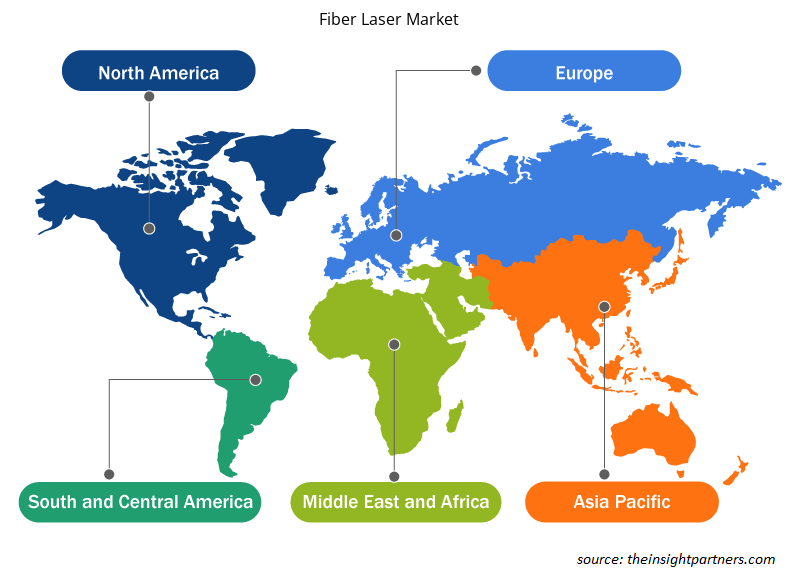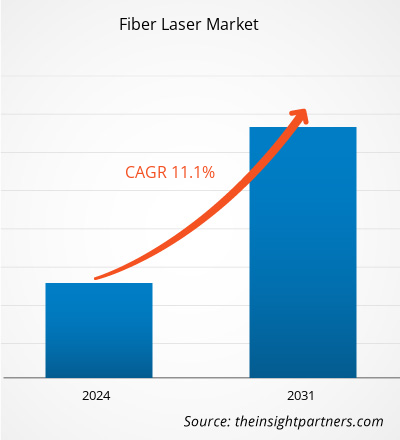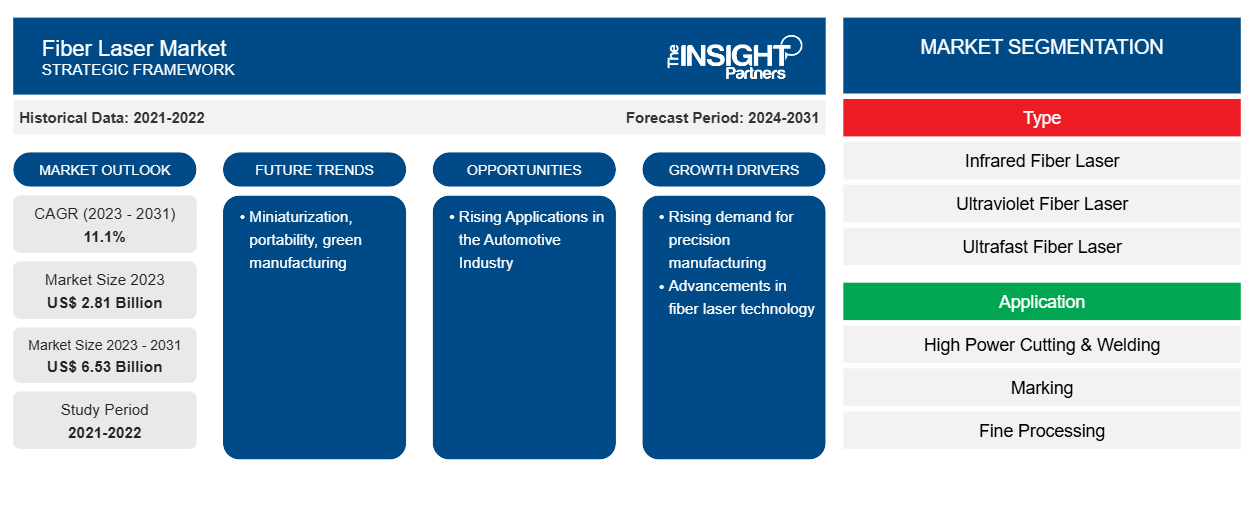Se prevé que el tamaño del mercado del láser de fibra alcance los 6.530 millones de dólares en 2031, frente a los 2.810 millones de dólares en 2023. Se espera que el mercado registre una CAGR del 11,1 % durante el período 2023-2031. Es probable que la miniaturización, la portabilidad y la fabricación ecológica sigan siendo una tendencia clave en el mercado.CAGR of 11.1% during 2023–2031. Miniaturization portability, and green manufacturing are likely to remain a key trend in the market.
Análisis del mercado de láser de fibra
Las aplicaciones de las máquinas de corte de materiales ultraduros se están expandiendo en una serie de industrias, entre ellas la de semiconductores y electrónica, minería y defensa. La integración de tecnologías de vanguardia, como los láseres de fibra, en las máquinas de corte ultraduros ha hecho esto posible. Se prevé que las tecnologías de láser de fibra encuentren una preferencia extraordinariamente alta después de que su precio baje a través del desarrollo de productos y una mayor competitividad en el mercado. Se sabe que las tecnologías de láser de fibra son aproximadamente treinta veces más rápidas que las máquinas de descarga eléctrica.
Descripción general del mercado del láser de fibra
En el mundo actual, los láseres de fibra se utilizan ampliamente. Se utilizan con frecuencia en entornos industriales para realizar tareas de corte, marcado, soldadura, limpieza, texturizado, perforación y muchas otras debido a las diversas longitudes de onda que pueden producir. También se emplean en otras industrias, como la atención médica y las telecomunicaciones. Existen numerosas aplicaciones para los láseres de fibra en el sector manufacturero. Los láseres de fibra de onda continua con requisitos de mantenimiento bajos o nulos son ideales para aplicaciones específicas de la industria pesada donde la eficiencia y la velocidad son especialmente cruciales. Por ejemplo, los láseres de onda continua son perfectos para el corte, la perforación y la soldadura por láser. Un instrumento ideal para cortes altamente especializados en formas complejas es un láser de fibra pulsado. Estas aplicaciones están impulsando el crecimiento del mercado.
Personalice este informe según sus necesidades
Obtendrá personalización en cualquier informe, sin cargo, incluidas partes de este informe o análisis a nivel de país, paquete de datos de Excel, así como también grandes ofertas y descuentos para empresas emergentes y universidades.
-
Obtenga las principales tendencias clave del mercado de este informe.Esta muestra GRATUITA incluirá análisis de datos, desde tendencias del mercado hasta estimaciones y pronósticos.
Factores impulsores y oportunidades del mercado del láser de fibra
La creciente demanda de fabricación de precisión favorecerá al mercado
El micromecanizado de características finas es ahora un componente crucial de la fabricación de gran volumen en una variedad de industrias, incluidas la electrónica de consumo, los dispositivos médicos y la automoción. Por el contrario, los láseres de fibra han surgido como el estándar de la industria para el marcado láser y el procesamiento macro. El panorama de la fabricación ha cambiado como resultado del corte por láser, que ofrece a las empresas mayor flexibilidad, velocidad y precisión. Con el avance continuo de la tecnología, se espera que el corte por láser tenga un mayor impacto en la forma en que se realizan la fabricación y la innovación en el futuro.micromachining is now a crucial component of
Aplicaciones en aumento en la industria automotriz
En términos de realizar cortes precisos y de alta calidad, el uso de cortadoras láser en la industria automotriz generalmente se ha considerado eficaz. Una gran cantidad de materiales se pueden cortar de manera rápida y efectiva con cortadoras láser. Esto se traduce en mejores tiempos de fabricación y menores costos. Además, proporcionan más uniformidad y precisión que las técnicas de corte convencionales, lo que puede reducir la cantidad de errores y fallas en el producto terminado. Dado que los cortes precisos permiten el uso eficaz de las materias primas, el uso de cortadoras láser también puede ayudar a minimizar el desperdicio de material. Debido a su pequeño tamaño, las cortadoras láser de fibra se pueden integrar fácilmente en los procesos de producción actuales y ocupan menos espacio.
Informe de mercado de láser de fibra Análisis de segmentación
Los segmentos clave que contribuyeron a la derivación del análisis del mercado del láser de fibra son el tipo y la aplicación.
- Según el tipo, el mercado de láseres de fibra se divide en láseres de fibra infrarrojos, láseres de fibra ultravioleta, láseres de fibra ultrarrápidos y láseres de fibra visibles. El segmento de láseres de fibra infrarrojos tuvo la mayor participación en 2023.ultrafast fiber laser, and visible fiber laser. The infrared fiber laser segment held the largest share in 2023.
- Según la aplicación, el mercado se divide en corte y soldadura de alta potencia, marcado, procesamiento fino y microprocesamiento.
Análisis de la cuota de mercado del láser de fibra por geografía
El alcance geográfico del informe del mercado del láser de fibra se divide principalmente en cinco regiones: América del Norte, Asia Pacífico, Europa, Medio Oriente y África, y América del Sur y Central.
La región de Asia Pacífico posee una participación significativa del mercado de láseres de fibra en 2023. La región cuenta con un importante centro de fabricación y una industria automotriz bien establecida. Los láseres de fibra encuentran importantes aplicaciones en estas industrias para la fabricación de precisión, lo que impulsa el crecimiento en la región.
Perspectivas regionales del mercado del láser de fibra
Los analistas de Insight Partners explicaron en detalle las tendencias y los factores regionales que influyen en el mercado del láser de fibra durante el período de pronóstico. Esta sección también analiza los segmentos y la geografía del mercado del láser de fibra en América del Norte, Europa, Asia Pacífico, Oriente Medio y África, y América del Sur y Central.

- Obtenga datos regionales específicos para el mercado de láser de fibra
Alcance del informe de mercado de láser de fibra
| Atributo del informe | Detalles |
|---|---|
| Tamaño del mercado en 2023 | US$ 2.81 mil millones |
| Tamaño del mercado en 2031 | 6.530 millones de dólares estadounidenses |
| CAGR global (2023 - 2031) | 11,1% |
| Datos históricos | 2021-2022 |
| Período de pronóstico | 2024-2031 |
| Segmentos cubiertos |
Por tipo
|
| Regiones y países cubiertos |
América del norte
|
| Líderes del mercado y perfiles de empresas clave |
|
Densidad de actores del mercado del láser de fibra: comprensión de su impacto en la dinámica empresarial
El mercado de láseres de fibra está creciendo rápidamente, impulsado por la creciente demanda de los usuarios finales debido a factores como la evolución de las preferencias de los consumidores, los avances tecnológicos y una mayor conciencia de los beneficios del producto. A medida que aumenta la demanda, las empresas amplían sus ofertas, innovan para satisfacer las necesidades de los consumidores y aprovechan las tendencias emergentes, lo que impulsa aún más el crecimiento del mercado.
La densidad de actores del mercado se refiere a la distribución de las empresas o firmas que operan dentro de un mercado o industria en particular. Indica cuántos competidores (actores del mercado) están presentes en un espacio de mercado determinado en relación con su tamaño o valor total de mercado.
Las principales empresas que operan en el mercado del láser de fibra son:
- Sistemas de fibra activa GmbH
- Corporación IPG Photonics
- Fujikura Ltda.
- Fotónica convergente
- Coherente, Inc.
- Jenoptik AG
Descargo de responsabilidad : Las empresas enumeradas anteriormente no están clasificadas en ningún orden particular.

- Obtenga una descripción general de los principales actores clave del mercado del láser de fibra
Noticias y desarrollos recientes del mercado del láser de fibra
El mercado del láser de fibra se evalúa mediante la recopilación de datos cualitativos y cuantitativos a partir de una investigación primaria y secundaria, que incluye publicaciones corporativas importantes, datos de asociaciones y bases de datos. A continuación, se enumeran algunos de los avances en el mercado del láser de fibra:
- La empresa de alta tecnología TRUMPF ha adquirido el 80 por ciento de Active Fiber Systems GmbH (AFS), una empresa con sede en Jena (Alemania) especializada en láseres de fibra. AFS desarrolla y fabrica sistemas láser de pulsos ultracortos y sistemas láser de fibra que se utilizan principalmente en la ciencia y la investigación. Además de la investigación básica, sus áreas de aplicación incluyen la generación de luz de longitud de onda extremadamente corta con alta coherencia, la obtención de imágenes biomédicas y el procesamiento de materiales. (Fuente: TRUMPF, nota de prensa, febrero de 2022)
- IPG Photonics Corporation (NASDAQ: IPGP), líder mundial en tecnología láser de fibra, presentará nuevas e innovadoras soluciones láser en The Battery Show del 12 al 14 de septiembre de 2023 en Novi, Michigan, EE. UU. IPG presentará una nueva fuente láser de haz de modo ajustable (AMB) capaz de lograr un haz láser monomodo de 3 kW en el núcleo. Este aumento de la potencia monomodo, una primicia en la industria, ofrece mejoras de velocidad y productividad sin precedentes para la soldadura de baterías con velocidades de soldadura sin salpicaduras hasta dos veces más rápidas que las posibles con potencias de núcleo más bajas. (Fuente: IPG Photonics Corporation, comunicado de prensa, agosto de 2023)
Informe sobre el mercado del láser de fibra: cobertura y resultados
El informe “Tamaño y pronóstico del mercado del láser de fibra (2021-2031)” proporciona un análisis detallado del mercado que cubre las siguientes áreas:
- Tamaño del mercado de láser de fibra y pronóstico a nivel global, regional y nacional para todos los segmentos clave del mercado cubiertos bajo el alcance
- Tendencias del mercado del láser de fibra, así como dinámicas del mercado, como impulsores, restricciones y oportunidades clave
- Análisis detallado de las cinco fuerzas de Porter y PEST y FODA
- Análisis del mercado de láser de fibra que cubre las tendencias clave del mercado, el marco global y regional, los principales actores, las regulaciones y los desarrollos recientes del mercado.
- Panorama de la industria y análisis de la competencia que abarca la concentración del mercado, análisis de mapas de calor, actores destacados y desarrollos recientes para el mercado del láser de fibra
- Perfiles detallados de empresas
- Análisis histórico (2 años), año base, pronóstico (7 años) con CAGR
- Análisis PEST y FODA
- Tamaño del mercado, valor/volumen: global, regional y nacional
- Industria y panorama competitivo
- Conjunto de datos de Excel
Informes recientes
Informes relacionados
Testimonios
Razón para comprar
- Toma de decisiones informada
- Comprensión de la dinámica del mercado
- Análisis competitivo
- Información sobre clientes
- Pronósticos del mercado
- Mitigación de riesgos
- Planificación estratégica
- Justificación de la inversión
- Identificación de mercados emergentes
- Mejora de las estrategias de marketing
- Impulso de la eficiencia operativa
- Alineación con las tendencias regulatorias























 Obtenga una muestra gratuita para - Mercado de láser de fibra
Obtenga una muestra gratuita para - Mercado de láser de fibra